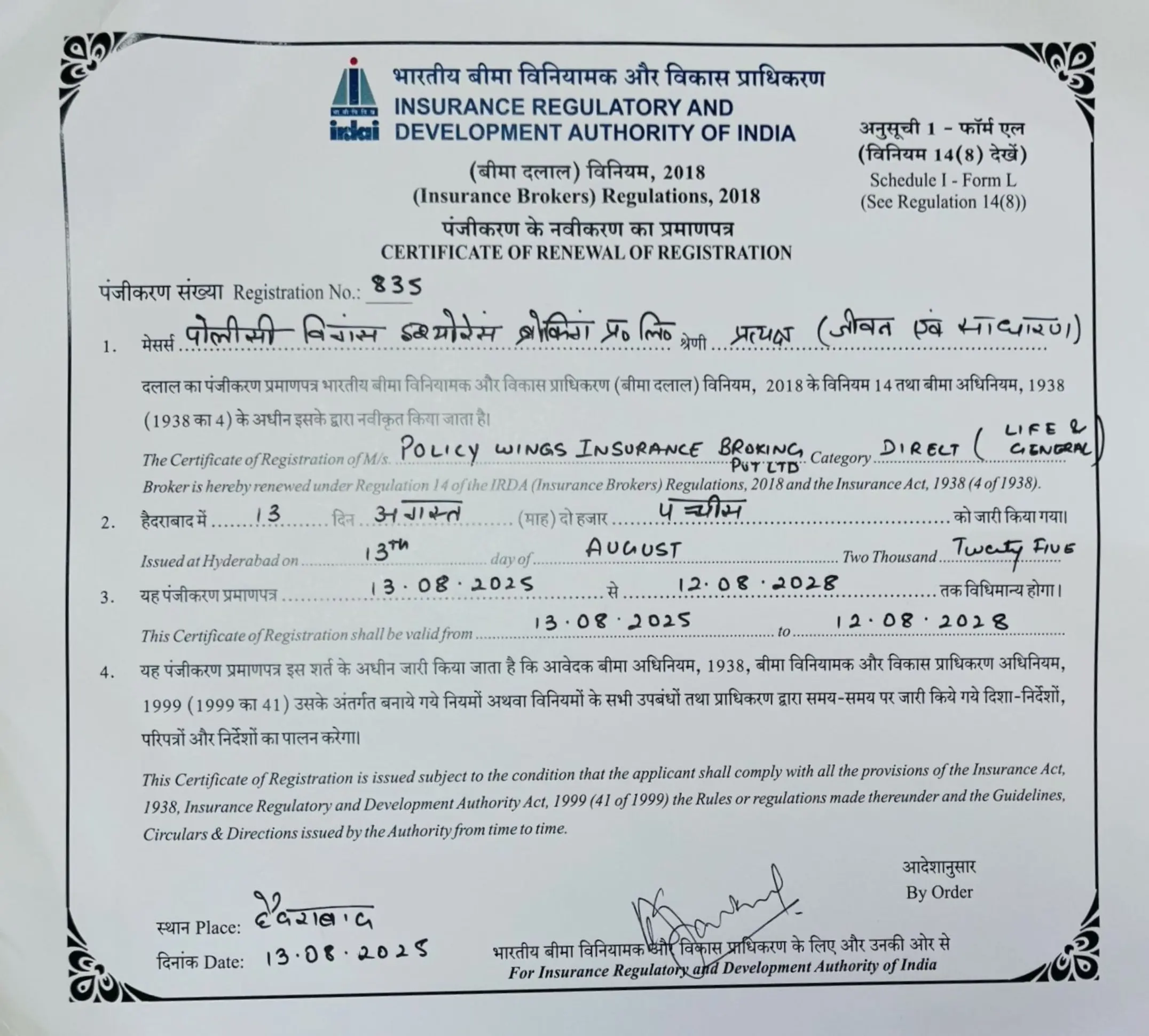Introduction Damage to property can be a huge loss. We need reliable property insurance to protect our home, workplace or any other valuable property against uncertainties. It’s certainly a must-have. But there are just so many different property insurance plans out there. Each insurance company makes the same promise. They claim to offer affordable premiums, extensive coverage and quick & easy claim settlements. With so many options, how do you know which one is actually the one for you? Comparing property insurance quotes is very important; it’s just like comparing prices before buying a gadget or maybe a bike. Only by analysing multiple insurance quotes can you find the perfect option that offers value for money. Why Property Insurance Matters Buying a property, whether a home or a place of work, means making one of the biggest investments. Any kind of damage to it due to fire, theft, accident or even a natural disaster leads to a huge financial loss that can only be covered with a property insurance policy. The right property insurance plans in place will: Protect your property from damaging natural disasters. Cover losses that may happen due to fire or explosions on the premises. Get protection for the loss in case of robbery. Stay protected in case of accidental damage. Continue with the business if it was a commercial property. Getting a property insurance plan gives you assurance that you won’t have to face the entire financial burden alone in case of an unexpected mishap. What Are Property Insurance Quotes? When you reach out to an insurance company to buy a policy, they give you a cost estimate for the kind of coverage you’re seeking. This is called a property insurance quote and it includes various information like: The premium: How much you will have to pay and the frequency (monthly, quarterly or annually). The coverage details: What all risks are covered and the maximum amount that’ll be received. The deductibles: How much would you have to pay from your pocket before the insurance comes into the picture. All the detailed terms and conditions of the insurance policy. Upon comparing property insurance quotes, you not only see the difference in the prices but also what you will actually pay for. Why It’s Important to Compare Property Insurance Quotes? Would you ever buy the car you see in the showroom without checking a few more? You won’t! And the same behaviour should be for insurance. Here’s why you must compare: Save Money– Different companies offer similar coverage but premiums may differ. When you compare, you can get the most cost-effective deal. Understand Coverage– Not all property insurance plans available will cover the same set of risks. For example, some companies just don’t include natural disasters. Avoid Surprises– Reading the details carefully helps you know what’s included and what’s not and hence, no shocks later during claims. Tailor to Needs– By comparing, you choose the correct plan for your property type, whether it’s residential, commercial, rental, etc. Best Ways to Compare Property Insurance Quotes Now comes the main part! How exactly should you compare quotes so that you end up making a smart decision? Look Beyond the Premium While it’s normal to check the price as the first thing, it’s not a good idea to get swayed by the cheapest property insurance quotes. A low premium often means either that the coverage is limited or the deductibles are high. Let’s say you might find one policy at ₹7,000 per year and the other one at ₹11,500. The catch is that the cheaper one doesn’t cover natural disasters, while the expensive one does. Hence, you get better value in the second one. Check the Coverage in Detail Not all property insurance plans will protect you against the same set of risks. The coverage should match your property type and location risks. So, make sure that all this is included: Damage due to fire and accident Natural calamities cover Theft or burglary Electrical or mechanical breakdown Third-party liability (you causing damage to another person’s property) Understand Deductibles Basically, a deductible is the amount you agree to pay before insurance kicks in and lower premiums usually have higher deductibles. When comparing property insurance quotes, don’t miss out on this point. Say your policy has a ₹40,000 deductible. So if your damage is ₹65,000 then the insurance will only cover ₹25,000. Compare Claim Settlement Ratios Getting a property insurance plan is only useful if the company doesn’t make a fuss while settling claims. You must check the claim settlement ratio of the insurer and learn how many claims they actually take action on. Even if the premium is slightly higher, go for a trusted insurer because a cheap plan might delay payments. Look for Add-Ons and Benefits Some insurers offer extra features. Adding them may slightly increase your premium but then the protection also becomes wider. You can consider: Rent loss cover: If you live in a rented house and it becomes unlivable after damage, the policy will help. Coverage for valuable contents inside the property: It provides coverage for jewelry, expensive appliances, etc. Temporary accommodation expenses: In case you can’t stay in your home after damage, that will be taken care of. Compare Policy Terms and Exclusions Always read the fine print because you might assume some coverage when it might not be there. Like some plans don’t include damages caused by negligence or damages from gradual wear and tear. And when you carefully compare property insurance quotes, you’ll know exactly what you’re getting. Check Flexibility of Payment Plans Some insurers allow you to pay premiums at your preferred duration. Monthly, quarterly or annually; you choose. You can always pick what fits your budget and which option helps you save more over time. Monthly vs Annual Premiums – Which is Better? When you have a bunch of property insurance quotes with you, you’ll notice that there is also an option of paying monthly or annual premiums. Here’s the difference:
...Introduction Finding cheapest property insurance India doesn’t mean you should sacrifice protection. For homeowners, landlords and small business owners, low cost property insurance and budget property insurance India options exist but the trick is to balance premium savings with meaningful cover. This article for Policywings explains how to get affordable cover, what to watch for and the recent regulatory changes that affect buyers. What “cheap” should really mean Cheap should mean “cost effective”, not “thin”. A low premium is attractive, but policies that exclude common perils or skimp on sums insured can leave you with large out of pocket losses. Look for a policy that covers both the building (structural damage) and contents (furniture, appliances) and check addons for important risks like flood, earthquake or theft. Consider replacements vs. indemnity bases, replacement cost cover costs more but avoids depreciation disputes at claim time. How insurers keep premiums low Insurers reduce premiums by using narrower cover, higher deductibles (excess) and risk based pricing. You’ll often find cheaper annual premiums if you: Raise the deductible (you pay more for small claims). Limit cover to specific perils (e.g. “fire & allied perils” vs. “all risks”). Install basic safety measures like smoke alarms, burglar grills or approved fire extinguishers and declare them when buying a policy, since many insurers offer discounts. Buy multi year or family/group policies, where available. Practical tips to find the cheapest policy without underinsuring Compare insurer quotes on Bima Sugam and major aggregators, but always verify product wording before buying. Bima Sugam aims to make offerings transparent and comparable. Calculate correct sum insured: undervaluing your property gives cheap premiums but leads to shortfall at claim time; overvaluing wastes money. Choose sensible addons only for example, include flood cover if you live in a flood prone region; skip niche riders you don’t need. Keep records like photographs, receipts and property plans speed up claims and reduce disputes. Recent regulatory changes and compliance you must know The insurance regulator has been active with new regulations in recent years, focused on product clarity, consumer protection and digitisation. In 2024-2025 the IRDAI updated consolidated regulations that affect product filings, solvency and policyholder protection; these set higher standards for product disclosures and grievance handling by insurers. Buying via regulated marketplaces and insurers that follow IRDAI product wordings helps ensure more consistent protection. In addition, the regulator has promoted Bima Sugam, a centralised electronic marketplace to improve choice and transparency for retail buyers, which can help you compare low cost property insurance plans more reliably. There are also active policy discussions and pilot ideas on climate linked and parametric insurance for disaster payouts, which if implemented nationally could change how flood and cyclone risks are priced and paid out. This is particularly relevant for property owners in climate vulnerable areas. Finally, IRDAI has been strengthening grievance resolution mechanisms; draft proposals include in-house ombudsman concepts to speed internal complaint redressal before escalation to external forums. This improves consumer protection when buying even budget policies. What to check in the policy document (must read clauses) Perils covered/excluded: floods and earthquakes are often excluded unless expressly added. Sum insured and basis of settlement: indemnity vs. replacement basis. Deductible/excess: higher deductibles lower premium but increase your exposure for smaller losses. Sub limits and depreciation: watch for limits on specific items (electronics, jewellery) and depreciation tables that reduce payouts. Claim process and timelines: look for insurer commitment on turnaround times and documentation requirements. When cheapest is NOT the right choice If your property is in a high risk zone (coastal, floodplain, seismic), buying the very cheapest plan may leave you exposed to catastrophic loss. Similarly, landlords with rental liability exposures or owners of high value contents should prioritise adequate limits and liability cover over lowest premiums. Quick checklist before you buy Verify the insurer is IRDAI registered. Read the product brochure/wording not just the marketing blurb. Check claim settlement ratio and sample claim timelines if available. Ask about discounts (multi year, security device, salaried). Keep an inventory with photos and proofs. Conclusion Affordable property protection in India is achievable with a disciplined approach: choose the right cover, use regulated comparison channels and stay informed about regulatory changes that improve transparency and claims handling. Policywings recommends prioritising correct sums insured and essential covers (fire, flood where needed and liability) because genuine value lies in the policy’s ability to restore your life after loss, not only in the premium paid.
...Introduction Damage to property can be a huge loss. We need reliable property insurance to protect our home, workplace or any other valuable property against uncertainties. It’s certainly a must-have. But there are just so many different property insurance plans out there. Each insurance company makes the same promise. They claim to offer affordable premiums, extensive coverage and quick & easy claim settlements. With so many options, how do you know which one is actually the one for you? Comparing property insurance quotes is very important; it’s just like comparing prices before buying a gadget or maybe a bike. Only by analysing multiple insurance quotes can you find the perfect option that offers value for money. Why Property Insurance Matters Buying a property, whether a home or a place of work, means making one of the biggest investments. Any kind of damage to it due to fire, theft, accident or even a natural disaster leads to a huge financial loss that can only be covered with a property insurance policy. The right property insurance plans in place will: Protect your property from damaging natural disasters. Cover losses that may happen due to fire or explosions on the premises. Get protection for the loss in case of robbery. Stay protected in case of accidental damage. Continue with the business if it was a commercial property. Getting a property insurance plan gives you assurance that you won’t have to face the entire financial burden alone in case of an unexpected mishap. What Are Property Insurance Quotes? When you reach out to an insurance company to buy a policy, they give you a cost estimate for the kind of coverage you’re seeking. This is called a property insurance quote and it includes various information like: The premium: How much you will have to pay and the frequency (monthly, quarterly or annually). The coverage details: What all risks are covered and the maximum amount that’ll be received. The deductibles: How much would you have to pay from your pocket before the insurance comes into the picture. All the detailed terms and conditions of the insurance policy. Upon comparing property insurance quotes, you not only see the difference in the prices but also what you will actually pay for. Why It’s Important to Compare Property Insurance Quotes? Would you ever buy the car you see in the showroom without checking a few more? You won’t! And the same behaviour should be for insurance. Here’s why you must compare: Save Money– Different companies offer similar coverage but premiums may differ. When you compare, you can get the most cost-effective deal. Understand Coverage– Not all property insurance plans available will cover the same set of risks. For example, some companies just don’t include natural disasters. Avoid Surprises– Reading the details carefully helps you know what’s included and what’s not and hence, no shocks later during claims. Tailor to Needs– By comparing, you choose the correct plan for your property type, whether it’s residential, commercial, rental, etc. Best Ways to Compare Property Insurance Quotes Now comes the main part! How exactly should you compare quotes so that you end up making a smart decision? Look Beyond the Premium While it’s normal to check the price as the first thing, it’s not a good idea to get swayed by the cheapest property insurance quotes. A low premium often means either that the coverage is limited or the deductibles are high. Let’s say you might find one policy at ₹7,000 per year and the other one at ₹11,500. The catch is that the cheaper one doesn’t cover natural disasters, while the expensive one does. Hence, you get better value in the second one. Check the Coverage in Detail Not all property insurance plans will protect you against the same set of risks. The coverage should match your property type and location risks. So, make sure that all this is included: Damage due to fire and accident Natural calamities cover Theft or burglary Electrical or mechanical breakdown Third-party liability (you causing damage to another person’s property) Understand Deductibles Basically, a deductible is the amount you agree to pay before insurance kicks in and lower premiums usually have higher deductibles. When comparing property insurance quotes, don’t miss out on this point. Say your policy has a ₹40,000 deductible. So if your damage is ₹65,000 then the insurance will only cover ₹25,000. Compare Claim Settlement Ratios Getting a property insurance plan is only useful if the company doesn’t make a fuss while settling claims. You must check the claim settlement ratio of the insurer and learn how many claims they actually take action on. Even if the premium is slightly higher, go for a trusted insurer because a cheap plan might delay payments. Look for Add-Ons and Benefits Some insurers offer extra features. Adding them may slightly increase your premium but then the protection also becomes wider. You can consider: Rent loss cover: If you live in a rented house and it becomes unlivable after damage, the policy will help. Coverage for valuable contents inside the property: It provides coverage for jewelry, expensive appliances, etc. Temporary accommodation expenses: In case you can’t stay in your home after damage, that will be taken care of. Compare Policy Terms and Exclusions Always read the fine print because you might assume some coverage when it might not be there. Like some plans don’t include damages caused by negligence or damages from gradual wear and tear. And when you carefully compare property insurance quotes, you’ll know exactly what you’re getting. Check Flexibility of Payment Plans Some insurers allow you to pay premiums at your preferred duration. Monthly, quarterly or annually; you choose. You can always pick what fits your budget and which option helps you save more over time. Monthly vs Annual Premiums – Which is Better? When you have a bunch of property insurance quotes with you, you’ll notice that there is also an option of paying monthly or annual premiums. Here’s the difference:
...Every business needs its physical assets for uninterrupted operations. While you can’t be 100% safe from situations like fire, theft or natural calamities, you can get commercial property insurance for the safe side. If you are not insured, recovering from such huge financial losses due to uncertain incidents can be next to impossible. You need it to protect the physical assets of your businesses and bounce back from an unexpected, devastating situation. A lot of businesses that faced fires, thefts or natural disasters had to shut down permanently because they did not have commercial property insurance. But those who had coverage managed to recover faster and continue working as usual. Let’s say a fire broke down in a small confectionery and it lost all its stock. But since it had coverage, it could replace everything and restart soon. What is Commercial Property Insurance? It’s a promising insurance policy that protects businesses from financial difficulties if their physical assets get damaged or lost. The assets that are typically included are: Buildings: If you own a workspace like a shop, office, warehouse etc, this insurance will cover any structural damage that happens to it so that expensive repairs don’t hold back your operations. Equipment: Whether you have computers or heavy machinery, it protects all tools of your trade which is a great relief for manufacturing businesses and service providers. Inventory: It covers the loss of raw materials, finished products and all the stock that was present in the premises. You can claim it in case there has been theft, fire or a disaster. Furniture & Fixtures: All essential furniture like workstations, tables, storage units, shelves etc are covered so that the workspace gets in the right condition once again. However, you must remember that everything is not covered. Here are the common exclusions: If the damage has been caused by war or terrorism, it requires separate policies. Age-related wearing and tearing is a maintenance issue that falls under business responsibilities. Those natural disasters that have not been specifically added to the policy will not be covered. Why is Commercial Property Insurance Essential? A single unfortunate event can ruin years of hard work and investment and leave you struggling to recover. In the worst case, businesses may even shut down permanently. The good news is that having property insurance for businesses works wonders because it: protects against unexpected events: A sudden fire, theft of assets, damage due to storms etc can happen anytime and leads to a big loss. But with an insurance policy, a business can get its inventory back and quickly recover. provides financial security: A disaster can ruin the property and the equipment. Insurance covers all the repair and replacement costs so the business can keep operating smoothly. meets legal and contractual requirements: Landlords often ask businesses to have insurance before they rent out their space. Banks offering a business loan may also ask for it to protect their investment. Benefits of Commercial Property Insurance A disaster can bring down the efforts of all the years to zero. Protecting your business is crucial. Commercial property insurance protects your business from uncertainties and helps you get back on your feet. Here are the benefits you get from an insurance for business property: Repair/ replacement costs are covered: The insurance covers everything from minor repairs to major replacements. All the expenses are taken care of so that businesses can recover without getting into financial burdens. Minimized downtime: Good coverage helps businesses recover quickly so they don’t face as much revenue loss. For example, a designer boutique whose stitching machines got burned could take up regular orders within a few weeks thanks to a quick insurance payout. Peace of mind: Entrepreneurs can focus on leveling up their business instead of worrying about the effects of unexpected disasters. They know that their business is protected and can operate with confidence. How to Choose the Right Commercial Property Insurance You can’t go for just any policy. It’s very important to find the commercial insurance coverage that matches your business requirements and provides you with the solutions you are looking for. Here’s what you must do to make the right decision: Assess your business needs: Risks differ for different locations, industries and asset values. You need to think of what can possibly hit your business. For example, if you are in a flood-prone area, you must have additional cover against the expected disaster. Compare policies and premiums: Not all insurance providers offer the same coverage options and prices. Do some research, check what’s included in different policies and then weigh all the options. Work with an insurance broker: It’s suggested to get in touch with a reliable professional. They will help you navigate different policies and find the most suitable one at the best price. That’s how you can get the essential protection without overpaying. Common Misconceptions About Commercial Property Insurance We discussed how a is so helpful when you need it. Still, a lot of people have their own myths about it and so they are not getting the coverage: Here are the most common false assumptions that people believe: My business is too small to need it– Disasters don’t look at the size of the business before hitting it. Even small businesses may experience theft, fires or any other unpleasant situation that will hurt them financially if they don’t have small business property insurance. General liability insurance is enough– Not at all. Liability insurance covers will never protect your physical assets, only injuries and lawsuits. If suppose there’s a burglary, your business will struggle without property insurance. It’s too expensive– If you look at the bigger picture, you will realize that the cost of insurance is not as much as the financial impact of an unexpected disaster. Find yourself an affordable policy that offers customized coverage. Asset protection without breaking the bank! Conclusion Don’t think of commercial property insurance as just another business expense because it’s something you won’t do without in case
...In the present capricious world, safeguarding your home and important belongings has never been more essential. Property insurance and home insurance are two fundamental defends that each homeowner ought to consider. In this article, we’ll dive into the significance of these insurance types, their advantages, and how to pick the right inclusion for your requirements. Figure out Property Insurance Property insurance is an expansive term incorporating different strategies intended to safeguard actual resources. Whether you own a house, business property, or other important resources, property insurance offers monetary security against harm or misfortunes brought about by unexpected occasions. Sorts of Property Insurance 1) Home Insurance Home insurance, a subset of property insurance, centers explicitly around protecting your home. It gives inclusion to harms to the construction, individual effects, and risk assurance if somebody is harmed on your property. 2) Business Property Insurance For entrepreneurs, business property insurance is vital. It safeguards your business property, stock, and gear from dangers like fire, burglary, or cataclysmic events, guaranteeing coherence notwithstanding difficulty. Advantages of Property Insurance 1) Inner harmony for Homeowners Homeowners can breathe a sigh of relief realizing that property insurance covers harms brought about by occasions like fire, robbery, or serious weather patterns. It likewise incorporates individual property inclusion, offering repayment for harmed or taken effects. 2) Business Security with Business Property Insurance For organizations, the strength presented by business property insurance is significant. It supports recuperating from monetary misfortunes by taking care of the expenses of property harm, permitting business people to zero in on business tasks without agonizing over startling costs. Pick the Right Property Insurance 1) Fitting Your Home Insurance Inclusion While choosing home insurance, evaluate your property’s estimation and items. Tweak your strategy to cover explicit dangers, for example, floods or quakes, which may not be remembered for standard inclusion. 2) Tweaking Business Property Insurance for Business Needs Organizations ought to painstakingly assess their insurance needs. Modify your business property insurance strategy to cover explicit dangers related to your industry, guaranteeing exhaustive security. Figuring out Home Insurance 1) Home Insurance Fundamentals: Design Inclusion Home insurance commonly incorporates inclusion for the design of your home. This truly means that assuming your home is harmed or obliterated by a covered hazard, for example, a fire, the insurance will assist with taking care of the expenses of fixes or reconstructing. 2) Individual Assets Inclusion: Safeguarding What Makes a Difference Notwithstanding primary inclusion, home insurance incorporates inclusion for individual things. This implies that your furnishings, apparel, hardware, and different belongings are safeguarded against covered risks. 3) Risk Insurance: Shielding Against Claims Home insurance additionally gives obligation assurance. Assuming somebody is harmed on your property, the obligation inclusion can help pay for clinical costs and legitimate expenses if you’re tracked down answerable for the injury. Advantages of Home Insurance 1) Monetary Security If there should arise an occurrence of Debacles Home insurance gives monetary security notwithstanding debacles. Whether it’s a characteristic catastrophe or an unexpected mishap, having the right inclusion guarantees that you won’t be left with overpowering fix or substitution costs. 2) Speedy Recuperation from Robberies and Burglaries In the sad case of thievery or burglary, home insurance steps in to cover the deficiency of taken things. This guides in recuperating monetarily as well as gives a conviction that all is good and true serenity. Picking the Right Home Insurance 1)Assessing Your Home’s Estimation To pick the right home insurance, begin by evaluating the worth of your home and its effects. Think about elements like the area, development materials, and the substitution cost of your assets. 2) Looking at Approaches: Viewing as the Best Fit Try not to make do with the primary home insurance policy you run over. Think about various strategies, taking into account inclusion cutoff points, deductibles, and any extra supports or riders that might be accessible. Last Words Property insurance and home insurance are essential apparatuses for safeguarding your most significant resources. Whether you’re a homeowner or an entrepreneur, figuring out the essentials, advantages, and ways to pick the right inclusion will engage you to settle on informed choices. Secure your home and assets today, guaranteeing a future set apart by inner harmony and monetary strength.
...Latest Blogs
Introduction Do you think that buying life insurance means having to go through complicated policies and paperwork and paying high premiums? Relax, because a life insurance term plan is actually one of the simplest and most effective forms of protection. It is specifically designed to protect your family financially in case something happens to you. Today, you can also buy insurance online. All the details that you need for choosing a term plan are now just a search away. Even then, so many people are postponing or avoiding. While some people think it’s not necessary at the moment, some just don’t fully understand how it works. This blog discusses what it is, how it works, what’s covered and what is it for so, let’s get reading! What Is a Term Insurance Plan? A life insurance term plan is entirely a protection policy in which you pay a fixed premium for a given period (policy term). If the policyholder passes away during this period, the insurance company pays a lump sum amount to the nominee. But if they survive the term, there is usually no payout on maturity. That’s all about it. No savings or investment involved, just financial protection. Why is Term Insurance Considered Essential Term insurance acts like income. Basically, if your family depends wholly on your earnings, a term plan will make sure that they can continue meeting the expenses even when you are not there anymore. It helps your family in these ways: In managing everyday household expenses Repaying the existing home, car or personal loans Fund education and future needs of the children Maintaining their standard of living Among all life insurance options available, it’s the term insurance that provides the highest coverage while being the most affordable. Key Features of a Term Insurance Plan This will help you know why term insurance is highly recommended: High Coverage at Low Premium: You get large life cover amounts at affordable premiums. This makes term insurance accessible even at a young age. Fixed Policy Term: The coverage period is your choice (like 10, 20 or 30 years). You can even have coverage until a certain age. Flexible Payout Options: In some plans, you can receive payments as lump sum, monthly income or a combination of both. Optional Add-On Riders: You can opt for useful riders like accidental death benefit, to enhance the policy. Simple and Transparent: The plan has nothing to do with hidden investment risks or market-linked returns. This makes it very easy to understand. What is Covered in a Term Insurance Plan? Natural Death: If the demise if due to illnesses like heart attack, cancer or other medical state. Accidental Death: Death due to unexpected accidents whether at home or outside. Critical Illness: You get financial support in case of severe or terminal illnesses. Pandemics: Deaths due to pandemics. Natural Disasters: Passing due to floods, earthquakes etc. Riders/ Add-ons: You can get extra coverage like accidental death benefit, critical illness or waiver of premium. What Is Not Covered Under Term Insurance? While the protection is broad enough, there are still certain exclusions. It doesn’t include death if: happened due to suicide within the early policy period caused by illegal or criminal activities it was due to undisclosed pre-existing conditions Who Should Buy a Term Insurance Plan? If you are somebody who has people dependent on you financially, you must get a life insurance term plan. Just don’t skip it if you are: The only or main earning member Married or planning a family A parent of young children Settling long-term loans Self-employed In fact, young professionals pay lower premiums if they purchase a plan in early years. Eligibility Criteria for Term Insurance in India While eligibility may differ for every insurance provider, here’s what is generally included: Age Conditions: Minimum entry age is usually 18 years and maximum entry age typically goes upto 60–65 years Income Requirement: Applicants have to show a stable income so as to justify the coverage amount Medical Evaluation: Given your age, coverage and health history, you may be asked to get some tests done. How Much Term Insurance Coverage Do You Need? Only the right coverage amount can ensure the financial security of your family. Below is a simple way to estimate it: Annual income × 10 to 15: This makes sure that your family continues to maintain their lifestyle for several years. Add outstanding loans: Loans that have to be repaid (home, car or personal) must be included. Factor in future goals: Consider education and marriage of children or other planned expenses. Subtract existing savings: Also add in any investments or insurance policies you have that can help your family. The ultimate goal is to ensure that your loved ones are able to manage expenses, debt and future plans and don’t get burdened under financial stress if something unexpected happens. Why It’s a Smart Move to Buy Term Insurance Early The common mistake that many people do is that they postpone term insurance because they think it’s needed later in life. Now, this delay can actually be costly. Benefits of buying early are: Lower and affordable premiums Better options to choose from Medical complications are reduced Coverage duration is longer Thankfully, there is an option to buy insurance online. It’s an easy and convenient way to secure protection early. Term Insurance vs Other Life Insurance Plans Opposite to the ULIPs or endowment plans, term insurance entirely focuses on protection. This means there is: No investment component No market risk No complicated calculations It’s the reason why term insurance is the foundation of a strong life insurance strategy. How to Choose the Right Term Insurance Plan The important tip here is to not keeping your focus only on premium. Rather, you should consider: Claim settlement record: It shows how much you can rely on the insurer for claims payout. Policy flexibility: If needed, this lets you make changes in term, coverage or premium. Coverage amount: This is
...Introduction You don’t buy a car insurance just fulfil a legal requirement. The repair costs have really increased, spare parts have become more expensive and road conditions can sometimes be so bad. The type of coverage you choose can actually have a big impact on your pocket. It’s common for car owners to get confused between Comprehensive Car Insurance and Bumper to Bumper Insurance. They either think that both options are the same or just not sure which one offers better value. It’s very important to understand this difference if you are on the hunt for the most effective yet cheapest insurance for car. While you get broad protection in both options, the main difference is in the way claims are settled and costs are covered. Let’s dive into the details of it. Understanding Car Insurance Before we go on to compare the two options, it’s important to understand does how car insurance generally works. So, in India, the law requires all car owners to have at least a third-party insurance policy. However, this one will pay for the damage or injury that is caused to others, not your own car or you. That highlights the need for choosing broader policies that will protect their owner’s vehicle as well. This is where car owners seek Comprehensive Insurance and Bumper-to-Bumper Insurance. They get a lot of benefits with it. What Is Comprehensive Car Insurance? It’s basically a standard policy under which you get full coverage and it also protects your car against different risks. What It Covers: Damage caused because of accidents Vehicle being stolen Fire and explosion Natural calamities Man-made disasters like riots Third-party liability (this is mandatory by law) However, there’s more to it. When a claim is made under comprehensive insurance, insurance providers deduct depreciation on the parts replaced like: Plastic components Rubber parts Fiberglass parts Tyres and batteries In simple words, it means that even though your policy is comprehensive, you will still not get 100% claim settlement. What Is Bumper-to-Bumper Insurance? This is not a separate policy but actually an add-on to comprehensive car insurance. It is also commonly known as Zero Depreciation Cover. But what makes it different is the biggest benefit that it offers. No depreciation is deduction on the replaced parts. Whether it’s plastic, rubber, or metal component, your insurer will pay the full cost of replacement (except for the consumables and deductibles). What this add-on covers: Everything that is covered under comprehensive insurance Full expenses of replacing the damaged parts A higher claim settlement value Clearly, bumper to bumper insurance is highly beneficial for new and expensive vehicles Main Differences Between Comprehensive and Bumper-to-Bumper Insurance Let’s assess both options on various factors: Depreciation Impact Comprehensive Insurance: Depreciation deduction at the time of claims Bumper-to-Bumper Insurance: No stress of depreciation deduction Claim Amount Received Comprehensive: You get partial reimbursement after deductions Bumper-to-Bumper: Almost 100% claim settlement is done Premium Cost Comprehensive: Premium is lower Bumper-to-Bumper: Premium is slightly higher but worth it Best For Comprehensive: Older cars or vehicles with low repair cost Bumper-to-Bumper: New and luxury cars, city driving Which One Is Cheaper in the Long Run? Do you think that you only need the policy with the lower premium? Actually, that’s not always the case. If you want to get the cheapest insurance for car, don’t just focus the premium amount; think beyond that. Example: The bumper of your car needs to be replaced and it will cost ₹20,000. Now, if you have a comprehensive insurance, your claim maybe reduced by ₹6,000–₹8,000 due to depreciation. But if you have bumper-to-bumper insurance, your insurer will pay almost the entire replacement amount. The upfront cost of bumper to bumper insurance is surely more but it can save you a lot during claims. This is especially helpful if repairs are frequent. When Comprehensive Car Insurance is the Best Choice? It’s may be enough to get comprehensive insurance if: Your car is over 5 years old The repair costs are usually low You drive only occasionally You don’t mind paying some part of repair costs You are looking for affordable car insurance along with basic protection For older vehicles, it often doesn’t make much sense to pay extra for bumper-to-bumper insurance. The benefits may just not be worth the higher cost. When do You Need Bumper-to-Bumper Insurance? You must definitely consider getting bumper to bumper insurance if: You have a new car or it’s less than 5 years old You live in a metro or traffic-heavy city Spare parts of your vehicle are expensive You want your claims to be stress-free You want maximum protection For new car owners, this add-on is a big relief. Often, it gives peace of mind that regular comprehensive insurance alone can’t provide. Common Myths Around Bumper-to-Bumper Insurance 1: It Covers Everything: It does NOT cover damage to engine because of water entry (unless you have an add-on), normal wear and tear or consumables like engine oil, nuts & bolts. 2: It’s Only for Luxury Cars: Even mid-range cars benefit because spare part costs are high. 3: It’s Too Expensive: The additional cost is usually small than the ultimate savings. How Claim Experience is Different Between the Two Policies Claim Aspect Comprehensive Car Insurance Bumper-to-Bumper Insurance Claim Approval Process Multiple depreciation calculations and estimate revisions are considered The approval is faster because of zero depreciation on most parts Out-of-Pocket Cost It’s higher and often unclear until all repair work is done Always lower and more predictable Interaction With Garage A lot of discussion happens around payable vs non-payable parts Negotiation with the workshop is minimal Repair Timeline Longer due to estimate adjustments might make it longer Generally quicker because settlement is simpler Claim Transparency You get the final payout amount is late in the process Better understanding of claim value from the early stage Stress Level for Owner Usually moderate to high, especially when making first-time claim Lower and more hassle-free Though both policies protect
...Introduction You can’t predict life but it’s always possible to secure the financial future of your family with life insurance. It is a very reliable financial protection that supports your loved ones in case something unexpected happens to you. Many people delay buying it when it should be a priority. They mistake it for being complicated, expensive or unnecessary (when young). From a practical standpoint, the right life insurance term plan should ideally be chosen early. This will be one of the most sensible financial decisions you make. Also, now, you can have all the convenience to buy insurance online. Here, we will discuss all the important details around it so that you know why it matters and what you must do. What Is Life Insurance? In simple terms, it is a deal between you and an insurance company. You will pay a regular premium for which the insurer pays a fixed amount to your nominee in case of your unfortunate death during the term of the policy. In fact, some policies even offer benefits to you if you survive the policy period. But basically, the purpose of life insurance is to protect your dependents from facing financial hardship after you. It will be correct to say that not just money, life insurance also protects people. Why Buy Life Insurance? If you take a look at the financial structure in India, you will notice that there are heavy responsibilities on individuals. In most of the households, everything depends on one or two earning members. In case there is a sudden loss of income, it can be such a challenge to handle everything whether it’s daily expenses or long-term goals. This is how life insurance helps: It replaces lost income for the family Settles loans like home or personal loans Funds education and marriage of children Dependents don’t have to exhaust their savings Provides peace of mind during uncertainties Types of Life Insurance in India We have life insurance available in different forms so that people can pick the most suitable as per their stage of life, goals and responsibilities. While each one serves a different purpose, ultimately, they all are designed to offer financial protection. Let’s learn about the types of life insurance plans: Term Life Insurance A life insurance term plan offers complete protection for a specific period like 20 or maybe 30 years. Usually, this is the first and vital life insurance policy that people buy. Nominee gets a lump sum if the policyholder passes away during the policy term Policyholders won’t get any maturity benefit if they survive This is the most affordable way to obtain a high life cover Term Insurance with Return of Premium (TROP) This is for those who want protection along with a way to create savings. Provides life cover throughout your policy term Returns all the premiums you have paid if you survive the term Because you get it all back, premiums are higher than regular term plans Unit Linked Insurance Plan (ULIP) This plan combines life insurance with market-linked investments for greater benefits. Great for long-term financial goals and investors that have a moderate risk taking capacity. A portion of the premium goes for life cover The rest of the amount is invested in equity or debt funds The returns you get depend on market performance Endowment Plan It offers both insurance and savings and is are preferred by those who want guaranteed benefits The plan pays the sum assured on death or maturity Disciplined savings are encouraged Returns are stable but generally lower Money Back Policy These plans provide regular payments during the term and are ideal for those who need funds at different stages of life. You get regular survival benefits at fixed intervals You keep getting life cover throughout the term Helps in meeting planned expenses Whole Life Insurance This offers coverage for almost the entire lifetime and is best for people who want lifelong financial protection. Usually provides coverage up to 99 or 100 years of age Nominees get guaranteed payout The premiums are higher compared to term plans Child Insurance Plan This helps you secure your child’s future. It makes sure that their goals stay protected even in difficult times. Helps in supporting education and important milestones Premium is waived off if the parent passes away The structure is mostly as that of an endowment or ULIP Retirement or Pension Plans They focus on offering financial stability after retirement and help maintain monetary independence in the golden years. Helps in building a nice retirement fund You receive regular income after retirement There may also be annuity or deferred payout options Group Life Insurance Plan These plans are usually offered by employers and are very useful. However, they should not be a replacement for individual life insurance. Covers all the employees under a single policy Basic life cover is provided at low cost Coverage usually ends with the employment Key Benefits of Having Life Insurance Besides providing financial support after death, life insurance offers many other major benefits like: Dependents get financial security Tax benefits under existing laws Policyholders get peace of mind for the Support is provided during essential life milestones Adequate coverage provides protection against inflation With a well-chosen policy, you can make sure that the lifestyle of your family remains stable even in when you are no longer there. How Much Life Insurance Coverage Do You Need? Coverage is not a random estimate. It has to be according to your financial responsibilities. Here’s a simple approach: Yearly income × 10 to 15 Also add in outstanding loans Future goals like education and marriage Subtract your existing savings This will give you a good a realistic and effective cover amount that you must consider. Why Buying Life Insurance Early is a Good Idea Many people assume that it’s too early to buy life insurance and often delay it. However, postponing it often leads to higher premiums and you have just limited choices
...Introduction You have waited so long to finally purchase that car, saved for it and checked all those reviews. And now that you have it, would you really take the risk of driving it without proper car insurance? Just one accident, a scratch or major repair work can cost you so much. This is why the right car insurance policy is as important as the right vehicle. But the problem is that a lot of people buy the cheapest insurance for car. They think that it’s enough for complete protection, when actually, these basic policies often offer only partial protection. For full-on protection, you need add-ons like bumper to bumper insurance along with proper understanding of how the claim process actually works. Let’s learn about it all! What Is a Car Insurance Policy? In simple terms, a car insurance policy is an agreement between you and your insurance provider. In this, you pay a set premium and in return, you will get financial protection during events like: Accidents Theft Fire Natural disasters Injury or property damage to third party In India, it’s compulsory to get a third-party insurance. However, it only covers the damage that you have caused to someone else and not your own car. That is the reason most car owners want comprehensive car insurance. Types of Car Insurance Policies in India Third-Party Car Insurance As per the law, it’s a mandatory requirement for all car owners. It covers damage caused to another person, vehicle or property Your own car is not covered in it It’s usually the cheapest insurance for car but not ideal fin terms of protection Comprehensive Car Insurance This one is recommended for all car owners because: It covers your car as well as third-party damage Provides protection against accidents, theft, fire and natural disasters Bumper to bumper insurance add-on makes it even more beneficial What All Does Comprehensive Car Insurance Cover? All car owners must ideally choose a comprehensive plan. It gives peace of mind and helps avoid hassles. This is what it usually includes: Damage that happened because of an accident Fire and explosion Floods, storms, earthquakes etc Theft Vandalism / riots Cover for personal accident Third-party liabilities What Is Not Covered? These are the exclusions that you must know of because this will help you avoid claim rejections. Accidents because of drunk driving Driving without a licence Mechanical breakdown Normal wear and tear Electrical failure Damage happened outside of the policy period Using a private car but for commercial use Add-Ons For Better Protection Add-ons are the extra yet optional covers that you can include to enhance your car insurance policy. Below are the most useful ones to consider: Bumper to Bumper Insurance (Zero Dep): This one is definitely the most popular add-on because it ensures no depreciation deduction during claims. Here, your insurer takes care of the full repair amount. It’s perfect for: New cars High-end cars Driving in cities with heavy traffic Engine Protect: It covers the damages that arise because of the entry of water, oil leakage or maybe a hydrostatic lock. Roadside Assistance: Helps with towing, jump start, battery help etc. Gives huge support during breakdowns. Return to Invoice (RTI): In case your car gets stolen or is totally damaged, you will get the original invoice amount and not the depreciated amount. Key Replacement Cover: Covers for the lost or stolen keys and is highly useful for high-tech keys. Consumables Cover: Items like nuts, bolts, engine oil and AC gas, that are usually excluded, are covered in this add-on. While add-ons like bumper to bumper insurance charge a little much, you also get to save a lot of money during repairs How to Choose the Right Car Insurance Plan? The aim is to balance protection and price. Here’s how you do it: Don’t just go on and pick the cheapest insurance that you get • Compare coverage and claim settlement ratio of multiple options • Always choose the correct IDV (Insured Declared Value) • Add zero depreciation cover for newer cars • Check the number of network garages listed with the insurer • Always read exclusions carefully If you compare smartly, you can totally ensure maximum protection without overspending. Steps in Car Insurance Claim Process If you follow these steps, it’s actually very easy to file a claim: Step 1: Immediately Inform the Insurer: Most insurers need you to notify them within 24–48 hours. Step 2: Take Photos of the Damage: When you have clear pictures, it helps in fast approval. Step 3: File an FIR: This is normally required for theft or major third-party damage. Step 4: Visit a Network Garage: The repairs are cashless. No upfront payment needed. Step 5: Surveyor Inspection: A surveyor checks the damage caused and gives approval for the repair estimate. Step 6: Repairs Begin: Garage starts working on your after getting approval. Step 7: Settlement: For cashless claims, the insurer pays directly to the garage. If applicable, you need to pay only for the deductibles. How to Lower Your Premium Without Losing Coverage These tips will help you enjoy good protection without have to spend more than required: Always renew on time • Don’t set a very low IDV • Make wise use of No-Claim Bonus • Install anti-theft devices in the car • Before renewal, compare different plans • Drive safely so that there are no frequent claims. Conclusion A car insurance policy is not just a legal compulsion but a financial protection against unexpected expenses of repairs. While cheapest insurance for car may seem more attractive but it often offers limited coverage. The smart thing to do is opting for a comprehensive plan with the right add-ons. This will give the most benefits. Understand the coverages, exclusions and the claim process and you can secure the most suitable policy. If you want easy comparison and expert guidance, Policywings can help you make the right decision!
...Introduction Upon buying insurance, you will notice different short forms in your policy documents that might confuse you. One of them is WFYP. It’s very commonly found in papers after the renewal of insurance premium for car or when you check the status of your health insurance premium payment. This short code often confuses people but it’s actually a very simple term to understand. Here, we will explain to you in the simplest way possible so that you know what you are agreeing to when buying a policy or learning your policy status. What Is WFYP Full Form in Insurance? So, WFYP is the short form for “Waiting For Your Premium.” This term in insurance is mainly used by insurance companies when your policy has been generated but the premium amount that you need to pay is still pending. Basically, it means that “Your policy is ready. Once you make the premium payment, we will activate it”. Your policy will not start till you make the payment. Why Does WFYP Matter? It is very important simply because the benefits of your policy will not start until the insurer receives the premium. Don’t just assume that you will be instantly protected after applying for a policy. WFYP clearly indicates that: Your application is accepted Your policy is all set and ready The company is only waiting for your premium so that your coverage can begin You can think of it like ordering food online. It will be prepared but you won’t get it without paying fir it. Why Insurers Use WFYP The real purpose behind using WFYP is used avoid confusion between the issued and an active policy because so many people make this mistake. Insurance companies use WFYP so that: Customers know that their payment is pending No claim is assumed without a premium receipt A record-based transparency is maintained Both parties know when the coverage starts When and Where You Usually See WFYP You can come across the term WFYP commonly during: Purchasing a new policy Renewing a car insurance policy Health insurance premium updates Porting to a new insurer Making changes in policy details Premium payments getting delayed It often shows up on: Policy dashboards SMS alerts Email updates App notifications Documents of proposal/issuance How WFYP Works: Step-by-Step Process Simply put, WFYP is the phase before insurance activation. Here’s how the actual WFYP process works in India: You select a plan: It could be car, health, life or any general insurance Submitting the application: Whether online or through an agent Reviewing your details: The insurer does KYC checks, run medical tests, does vehicle inspection, verifies documents etc. The policy gets approved: Your policy number is generated. Status changes to WFYP: The insurer is now waiting for your premium payment to be made. You pay the premium: Whether through UPI, card, net banking or cash Policy becomes immediately active: Payment is received and now claims are valid. What Happens If You Ignore a WFYP Status? WFYP is a clear message that your policy is not completed yet. You should not ignore it because: You won’t be having insurance protection Claims made will be rejected Your vehicle would be uninsured and this is illegal in India Health benefits don’t start till you make the payment Your policy may be cancelled if the premium is unpaid WFYP in Car Insurance For car owners, WFYP matters more than you think. It directly affects the insurance premium for car and also your legal safety. If your car insurance shows WFYP, it should be cleared immediately because otherwise: You can’t claim for any accidents or damages Third-party liability coverage won’t be active There may be fines if caught without active insurance If it’s a new car, the dealer may not release it without premium confirmation WFYP in Health Insurance Health insurance only works after the premium is paid. Thus, the health insurance premium must be cleared on time. If your policy shows WFYP, it means: Hospitalisation is not covered Cashless treatment is not allowed Waiting periods are not started Benefits for pre-existing disease are not active If overdue, renewal continuity can break Key Benefits of WFYP for Policyholders WFYP is not to be scared of; it’s actually helpful for the customers in many ways: Clear communication: With clear updates, you can instantly know where your policy stands. Prevents misunderstanding: There are no assumptions. You would know when the coverage starts and whether you are insured or not. Helps avoid claim disputes: All the details are clear before the policy gets active. Works as a reminder: Helps with timely premium payment so your policy doesn’t lapse. Tracks policy progress: You can know your policy is at which stage and can also be tracked step-by-step. How to Quickly Clear WFYP Just with a few minutes of attention, you can ensure uninterrupted protection. This is what you should do to avoid delays: Clear the premium payment immediately after the policy is approved Turn on updates (SMS/Email/WhatsApp) from your insurance company Enable auto-debit for car and health insurance, if possible Avoid waiting till the last day of the renewal Keep UPI/card details updated Keep the payment receipts with you for reference Conclusion WFYP simply means you must pay now to activate your coverage. Your insurance company has issued your policy, but your coverage starts once the premium is paid. Coming across a new term like WFYP, waiting for your premium, etc may bring multiple thoughts but aim to understand it. It will help you stay informed and you can avoid claim-related issues. If at all it feels overwhelming and you want a smoother experience, PolicyWings will guide you through the entire process. Let’s help you stay fully protected without stress.
...Introduction Travel is exhilarating but medical emergencies abroad are expensive and unpredictable. For Indian travellers, buying robust overseas travel medical insurance before boarding is not optional if your destination or visa requires it and it’s strongly recommended in every other case. This article explains what international travel health insurance covers, what to check in policy wordings and the recent regulatory and entry rule updates you must know before you fly. What “overseas travel medical insurance India” covers Overseas travel medical insurance (also called international travel health insurance or medical insurance for abroad travel) typically includes: Emergency medical treatment and hospitalisation abroad (up to the sum insured). Medical evacuation and repatriation of remains. Emergency dental treatment for acute pain. 24/7 assistance and case management (hospital referrals, direct billing help). Optional add ons: trip cancellation/ interruption, lost baggage, personal liability and adventure sports cover. Always confirm limits for hospitalisation, in patient vs out patient care and whether medical evacuation is included or subject to separate approvals. Visa and entry requirements you must meet Several countries require proof of visa compliant travel medical insurance at application or entry. The Schengen Area, for example, still requires a minimum emergency medical coverage of €30,000 covering repatriation and urgent hospital treatment and the policy must be valid for the entire stay. Many embassies list approved wording or insist on a specific territorial scope (e.g., worldwide excluding the traveller’s country of residence). Note: Some countries control health access through immigration fees or surcharges (e.g., the UK’s immigration health surcharge for certain visa types), which is separate from private travel insurance and may still apply even if you hold private cover. Indian regulatory context and recent updates Insurance products sold in India (including overseas travel policies) fall under the Insurance Regulatory and Development Authority of India (IRDAI). IRDAI’s health department publishes master circulars, product guidelines and model wordings that insurers use to design travel products; a formal overseas travel policy wording and master travel policy documents are available on the IRDAI portal. Insurers must adhere to these standards when offering travel medical cover from India. While there is heightened regulatory attention on product standardisation, as of October 2025 there is no blanket government mandate that every Indian leaving the country must purchase a single standard travel policy however, IRDAI guidance and master circulars shape minimum disclosure, claims handling and policy wording that affect what insurers sell and how claims are processed. Always check the insurer’s policy wording and IRDAI circulars for updates before purchase. Practical points when buying medical insurance for abroad travel Buy before departure visa processing often expects the policy to be active for the whole trip. Check the territorial cover and currency (Schengen accepts EUR; many embassies want specific currency equivalence). Verify evacuation & repatriation limits these costs can be enormous and are the primary reason to choose a higher medical limit. Declare pre-existing conditions and read waiting periods; nondisclosure can void claims. Confirm direct billing or cashless arrangements with the insurer’s assistance partner. Check pandemic/COVID clauses many insurers continue to offer COVID treatment cover but terms vary. Claims, documentation and assistance Keep digital and printed copies of: Policy certificate and emergency assistance number. Hospital invoices, medical reports, prescriptions and scans. Police reports (for accidents), airline PIR (Property Irregularity Report) for baggage loss and any embassy/consulate correspondence if needed. Contact the insurer’s 24/7 assistance team before receiving treatment where possible some policies require the assistance provider’s pre approval for evacuation or hospital admission. New entry/processing systems that matter to travellers The EU Entry/Exit System (EES) and related rollouts (and the future ETIAS waiver) have changed border checks across many European ports during these checks travellers may be asked routine questions about accommodation, return tickets and insurance. Although EES itself does not create new insurance requirements, it has increased the likelihood that border officials will query travellers about whether they hold travel insurance which highlights the importance of carrying proof of valid cover. Who should consider higher limits or specialised cover? Long stay students and expatriates (consider student or expatriate health plans). Travellers to remote or high cost countries (USA/Canada require high cover due to medical costs). Adventure travellers ensure sports/activities are covered. Senior travellers or those with multiple pre existing conditions specialised senior travel plans often include higher premiums and specific underwriting. Final checklist Read the policy wording end to end to know exclusions and waiting periods. Ensure sum insured and repatriation limits meet your destination’s requirements. Buy visa compliant cover if your destination mandates it (Schengen and several others). Carry both digital and paper copies; save the assistance number in your phone. Contact Policywings for tailored comparisons if you have specific needs (long stays, pre-existing conditions or adventure activities). Overseas medical emergencies are both traumatic and expensive. Having the right international travel health insurance turns a potentially ruinous bill into a manageable claim and ensures you get timely medical help and repatriation when needed. If you’re planning a trip, start with destination specific requirements and the insurer’s assistance network and choose cover that gives you practical, on ground support not just a promise on paper.
...Introduction Having a small business in India starts with immense opportunities but also with a wide range of challenges. Moreover unforeseen occurrences like fire mishaps, legal conflict, cyberattacks or property damage can destroy business functions and can create financial risks. This is why learning about business insurance costs is important for all small and medium enterprises (SME). Insurance gives financial security and also a peace of mind which allows businesses to concentrate on growth while preparing for incidental events. Why Small Businesses Need Insurance One huge misfortune can be difficult to recover for a small company or a startup. Large corporations have multiple revenue streams but SMEs generally function with limited resources. A lawsuit or an accident on company premises or even a data breach could influence cash flow and also lower the company’s reputation. This is why SME insurance is essential. It makes sure that unforeseen costs are controlled by the insurer instead of the business consuming the whole financial risk. Having insurance coverage even increases credibility with clients, investors and partners. Many corporate clients prefer working with vendors who are correctly insured as it shows financial responsibility and long term stability. Influence on Business Insurance Cost The cost of insurance for small businesses in India is not consistent. Many elements establish the premium amount and learning about these can boost SMEs to make sound choices. The industry type plays an important part. For example a manufacturing unit trading with high weight machinery may pay extra for insurance than a consulting firm due to higher risk exposure. The size of the company which also includes revenue, total employees and geographical area which affects the premium. Companies with more than one office or warehouses are likely to need higher coverage compared to smaller functionalities. The type of coverage chosen is another important element. A comprehensive policy covering property damage, liability and cyberattacks will cost more than a basic plan providing limited protection. The history of claims can also influence premiums. Businesses with a record of constant claims are likely to face more insurance costs. In the end the location is also important. Companies functioning in high risk areas are more prone to natural disasters, hazards or theft which may pay more for insurance compared to those in safer areas. Common Business Insurance Cost for SMEs Although accurate costs differ still most of the SME insurance premiums are moderately affordable considering the safeguard they offer. A small consulting firm with 10 to 15 employees may pay between INR 25,000 to INR 50,000 yearly for professional indemnity and liability coverage. A retail shop or small manufacturing unit may pay INR 50,000 to INR 1,50,000 yearly conditional on the level of property and asset protection requirement. Cyber liability insurance is increasingly getting popular among IT and digital service providers which can range from INR 20,000 to INR 1,00,000 yearly conditional on data exposure. Group health insurance for employees is another common coverage among SMEs which typically costs around INR 6,000 to INR 10,000 per employee yearly. These figures are suggestive, most likely to be assumed and can differentiate based on the insurer, coverage options and risk profile of the business. Policywings help SMEs strategise or compare plans and can offer cost effective solutions customised to their needs. Types of Insurance Policies That Affect Costs Under business insurance costs it is important to know the types of coverage which are available for SMEs. Property insurance protects office spaces, warehouses and equipment against fire, theft or natural disasters. Liability insurance covers legal costs in case of third party claims. Professional indemnity insurance safeguards service based firms such as consultants, auditors and IT companies from errors or negligence claims. For businesses with an online presence, cyber liability insurance is increasingly essential. SMEs that manufacture or supply goods mostly go for product liability coverage to protect against claims related to defective products. Additionally, group health insurance is widely chosen by SMEs to provide employee benefits and attract talent. Each of these policies adds to the total insurance cost but all together they provide comprehensive safeguard. Management of Business Insurance Costs Small businesses mostly function with small budgets as it’s important for them to manage insurance costs effectively. The initial step is recognising risks carefully. All companies do not require every type of coverage. For example a small consultancy can have professional indemnity insurance over product liability coverage. Selecting policies based on real business risks makes sure that SMEs do not exhaust money on not required protections. Comparing quotes from various insurers also makes a visible difference in premium costs. Involving advisors or digital platforms like Policywings can also help SMEs get transparent comparisons and choose policies that can balance affordability with comprehensive coverage. Selecting increased deductibles where the business agrees to carry a small portion of the loss can also decrease premium amounts. Maintaining a good claims history can make a significant change as well as it can keep costs under a grip. Businesses that apply safety protocols, cybersecurity extents and compliance practices are mostly rewarded with lower premiums by insurers. Conclusion Knowing business insurance costs is important for small companies wanting to protect their functionalities from unforeseen events or risks. While premiums differ depending on industry, size, coverage and location where protection insurance offers high costs. For SMEs insurance is not an extra spending but an investment in stability and development.
...Introduction Ever seen a hospital bill after a surgery or a few weeks of stay? It’s in lakhs! With our parents or grandparents growing older and who may already have health conditions, managing healthcare expenses is one huge worry. One emergency can take away years of savings and this makes having the best senior citizen health insurance a must. But with all insurers claiming to provide the ideal health insurance plans, making a decision becomes very tricky. A policy that looks affordable may not offer important coverage and the other provides good coverage but has high premiums or hidden clauses. So, how do we land the best health insurance policy for seniors? We’ll find out! Why Senior Citizens Need Special Health Insurance Health risks naturally increase with age. Growing older, especially in the 60s, it’s common to get affected with lifestyle diseases, chronic conditions and of course, age-related health issues. Senior citizens often need more to visit doctors more frequently and then there are medicines, or even hospital care. Families that don’t have insurance for senior citizens often have to pay out of their own pocket and this is a huge financial burden. However, a dedicated senior citizen health insurance plan will make sure that you get: Coverage for pre-existing diseases like diabetes, high BP etc Cashless treatment in a hospital near you that falls under the tie-ups Security of medical needs and peace of mind for the whole family. Many people feel that senior citizen health insurance is a way to give back to their parents. It’s a security that ensures they don’t have to worry about funds when they need care. Key Features of the Best Senior Citizen Health Insurance There are several policies available and each one is different in some or the other way. But what truly makes a policy the best senior citizen health insurance are these features: Comprehensive Coverage The reliable plan offers wide coverage. It includes hospitalization and surgeries, day-care procedures and critical illnesses and doesn’t leave policyholders disappointed during treatments. Pre-Existing Disease Coverage It’s common for seniors to be living with certain health conditions. The best health insurance policy for seniors doesn’t come with long waiting periods and the coverage starts as early as possible. High Sum Insured Options Medical treatments come with huge bills. A policy that offers a higher sum insured, like ₹5–20 lakhs or more, will always provide better protection when needed. Cashless Hospital Network When the policies have tie-ups with a large number of hospitals, admission and treatment become stress-free. Treatment begins without delay and there is no need to arrange money during emergencies. Low Co-Pay or No Co-Pay Under some health insurance plans, the insured has to co-pay a part of the hospital bill. A plan with lower or no co-pay is a lot more beneficial for seniors. Affordable Premiums With your age, premiums also increase. A good policy is one that balances cost with benefits so that coverage continues without being unaffordable. Things to Consider When Buying Insurance for Senior Citizens While you must look at the benefits when choosing insurance for senior citizens, you must also understand what could go wrong. Here’s what you must definitely check: Room Rent Limits: Some policies cap the room rent and exceeding it means paying extra costs. Disease-Specific Limits: There may also be coverage limits for certain health conditions. Go through the details properly to avoid any confusion later. Waiting Periods: The waiting period of some plans makes seniors wait for a few years before the coverage starts for pre-existing diseases. Hence, the shorter, the better. Exclusions: Every policy has some exclusions. Like they might not cover for cosmetic surgeries or maybe self-inflicted injuries and other things. So, know what’s covered. Group vs Individual Plans for Seniors There are times when senior citizens may be covered under a family health insurance or corporate group plan. Of course, that’s helpful but you can’t rely only on these. Family Health Insurance: It might not offer enough sum insured in case multiple members of the family need it at the same time. Corporate Group Insurance: The policy ends when the employee retires or switches job. Buying a dedicated senior citizen health insurance policy is always a safer choice because then you get lifelong protection. Comparing Policies to Pick the Best Below are the super-important factors that should be kept in mind while you’re comparing the best health insurance plans: Coverage vs. Premium: Merely being the cheapest is not enough. It should cover major needs like pre-existing conditions, hospitalization and critical diseases. Claim Settlement Ratio: Pick a company with a good claim record because it ensures smooth approvals. Customer Service: We all expect quick and helpful support during emergencies. Renewability: The best health insurance policy for seniors can be renewed without any age restrictions. Let’s take an example of Mr. Gupta (65 YO) and Mrs. Gupta (62 YO), who need health insurance and they have two options: Plan A: While it has a low premium but hospitalization is covered only after a 4-year waiting period for pre-existing diseases. Plan B: Charges a higher premium but you need to wait just 1 year for hospitalization, critical illnesses, day-care treatments and treatment of pre-existing disease. So, which is the best senior citizen health insurance for them? Plan B! Because Plan A seems affordable but won’t help if a hospital stay is required in the next 1-2 years for some pre-existing conditions. Hidden Clauses to Watch Out For Before you sign the agreement, take some time and read the brochure carefully because there may be some common traps that can turn into ugly surprises: The waiting periods for pre-existing diseases can sometimes be as long as 4 years. There may be disease-specific sub-limits as well like cataract cover could be limited to ₹23,000 per eye or ₹47,000 for joint replacement. Dental, cosmetic or self-inflicted injuries are often not included in the plan. Surprisingly, some insurers also increase the premium amount after
...














